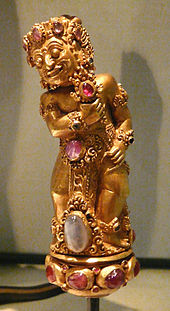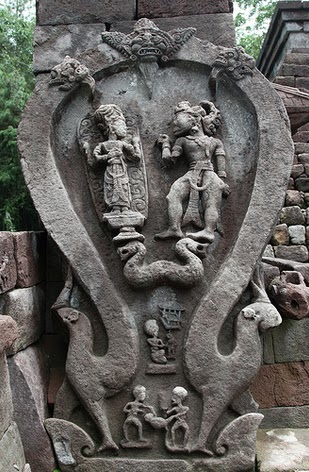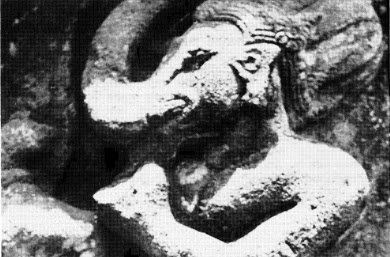Meluhha hieroglyphs and Candi Sukuh hieroglyphs related to metalwork
The relationship between Munda and Khmer languages in the family of Austro-Asiatic languages is as yet an unsettled research concern. In the context of Meluhha, it is clear that in Indian sprachbund from ca. 5th millennium BCE, Munda words were an integral component of the language union. FBJ Kuiper has demonstrated the presence of Munda words in Samskritam. Kuiper FBJ, 1948, Proto-Munda words in Sanskrit, ord-Hollandsche Uitg. Mij. in Amsterdam.See: http://en.wikipedia.org/wiki/Substratum_in_Vedic_Sanskrit
It is possible that many of the Meluhha hieroglyphs and related metalwork glosses may also have been in vogue in the region characterised by the Khmer languages exemplified by Tantri Kamandaka in Javanese and in the Ganapati image of Candi Sukuh in Java, discussed in this note.
There are clear indicators that the Candi Sukuh hieroglyphs were comparable with metalwork hieroglyphs of Indus script corpora and with the art forms of Ganapati found over an extended area of Bharatam and neighbouring contact areas.
S. Kalyanaraman
Sarasvati Research Center
Sarasvati Research Center
January 14, 2015
 Map of Bronze Age sites of eastern India and neighbouring areas: 1. Koldihwa; 2.Khairdih; 3. Chirand; 4. Mahisadal; 5. Pandu Rajar Dhibi; 6.Mehrgarh; 7. Harappa;8. Mohenjo-daro; 9.Ahar; 10. Kayatha; 11.Navdatoli; 12.Inamgaon; 13. Non PaWai; 14. Nong Nor;15. Ban Na Di andBan Chiang; 16. NonNok Tha; 17. Thanh Den; 18. Shizhaishan; 19. Ban Don Ta Phet [After Fig. 8.1 in: Charles Higham, 1996, The Bronze Age of Southeast Asia, Cambridge University Press].
Map of Bronze Age sites of eastern India and neighbouring areas: 1. Koldihwa; 2.Khairdih; 3. Chirand; 4. Mahisadal; 5. Pandu Rajar Dhibi; 6.Mehrgarh; 7. Harappa;8. Mohenjo-daro; 9.Ahar; 10. Kayatha; 11.Navdatoli; 12.Inamgaon; 13. Non PaWai; 14. Nong Nor;15. Ban Na Di andBan Chiang; 16. NonNok Tha; 17. Thanh Den; 18. Shizhaishan; 19. Ban Don Ta Phet [After Fig. 8.1 in: Charles Higham, 1996, The Bronze Age of Southeast Asia, Cambridge University Press].Pinnow’s map of Austro-AsiaticLanguage speakers correlates with bronze age sites. See: https://sites.google.com/site/kalyan97/indian-hieroglyphs-meluhha-and-archaeo-metallurgy![<b>Munda</b> (reddish) and Mon-Khmer languages]() http://www.ling.hawaii.edu/faculty/stampe/aa.html Map 1 (Bronze-age sites) correlates with Austro-Asiatic languages map 2. A focus on this area for areal linguistics will yield significant results to delineate the ancient structure and form of mleccha language. Santali and Munda lexicons and literature will be of considerable relevance with particular reference to cultural traditions and village festivals associated with the work on minerals and metals.
http://www.ling.hawaii.edu/faculty/stampe/aa.html Map 1 (Bronze-age sites) correlates with Austro-Asiatic languages map 2. A focus on this area for areal linguistics will yield significant results to delineate the ancient structure and form of mleccha language. Santali and Munda lexicons and literature will be of considerable relevance with particular reference to cultural traditions and village festivals associated with the work on minerals and metals.
 http://www.ling.hawaii.edu/faculty/stampe/aa.html Map 1 (Bronze-age sites) correlates with Austro-Asiatic languages map 2. A focus on this area for areal linguistics will yield significant results to delineate the ancient structure and form of mleccha language. Santali and Munda lexicons and literature will be of considerable relevance with particular reference to cultural traditions and village festivals associated with the work on minerals and metals.
http://www.ling.hawaii.edu/faculty/stampe/aa.html Map 1 (Bronze-age sites) correlates with Austro-Asiatic languages map 2. A focus on this area for areal linguistics will yield significant results to delineate the ancient structure and form of mleccha language. Santali and Munda lexicons and literature will be of considerable relevance with particular reference to cultural traditions and village festivals associated with the work on minerals and metals. Cham Art. "History has not been kind to Cham monuments and works of art: centuries of warfare and casual neglect have taken a significant toll on sites like My Sonand Po Nagar Nha Trang, while decorative pieces have been lost over time. Today, most Cham artifacts exist as sandstone or bronze sculptures, with a few decorative objects cast in other metals. Do we know anything about the other arts of the ancient Cham: painting, jewelry, basketry, textiles, pottery, or even calligraphy? Can sources from abroad or surviving steles allow us to reconstruct what other arts were practiced during Champa’s zenith (c. 600-900 CE)? " http://etc.ancient.eu/2013/04/03/deciphering-ancient-cham-art/
Cham Art. "History has not been kind to Cham monuments and works of art: centuries of warfare and casual neglect have taken a significant toll on sites like My Sonand Po Nagar Nha Trang, while decorative pieces have been lost over time. Today, most Cham artifacts exist as sandstone or bronze sculptures, with a few decorative objects cast in other metals. Do we know anything about the other arts of the ancient Cham: painting, jewelry, basketry, textiles, pottery, or even calligraphy? Can sources from abroad or surviving steles allow us to reconstruct what other arts were practiced during Champa’s zenith (c. 600-900 CE)? " http://etc.ancient.eu/2013/04/03/deciphering-ancient-cham-art/ "The handle or hilt (hulu) is an object of art, often carved in meticulous details and made from various materials: precious rare types of wood to gold or ivory. They were often carved to resemble various Hindu gods and deities, although this became less common with the introduction of Islam. In Bali, kris handles are made to resemble demons coated in gold and adorned with semi precious and precious stones, such as rubies. In Java, kris handles are made in various types, the most common design being the abstract stylized representation of the human form." http://en.wikipedia.org/wiki/Kris

The main monument of Sukuh temple.
The walls of the monument which is Sukuh candi (15th cent. temple) in Indonesia (Java) have many bas-reliefs.
boar, a hog (Santali) baḍhi ‘a caste who work both in iron and wood’
(Santali) baṟea ‘merchant’ ibha 'elephant' Rebus: ib 'iron' (Santali)

A headless life-sized male figure grasping penis
Ko. geṇḍ kaṭ- (kac-) dog's penis becomes stuck in copulation. Ka. geṇḍe penis.
Go. (Tr. Ph.) geṭānā, (Mu.) gēṭ- to have sexual intercourse; (Mu.) gēṭ sexual intercourse (Voc. 1181).(DEDR 1949).
gaṇḍá4 m. ʻ rhinoceros ʼ lex., °aka -- m. lex. 2. *ga- yaṇḍa -- . [Prob. of same non -- Aryan origin as khaḍgá --1: cf. gaṇōtsāha -- m. lex. as a Sanskritized form ← Mu. PMWS 138]1. Pa. gaṇḍaka -- m., Pk. gaṁḍaya -- m., A. gãr, Or. gaṇḍā. 2. K. gö̃ḍ m., S. geṇḍo m. (lw. with g -- ), P. gaĩḍā m., °ḍī f., N. gaĩṛo, H. gaĩṛā m., G. gẽḍɔ m., °ḍī f., M. gẽḍā m.Addenda: gaṇḍa -- 4. 2. *gayaṇḍa -- : WPah.kṭg. geṇḍɔ mirg m. ʻ rhinoceros ʼ, Md. genḍā ← H. (CDIAL 4000). காண்டாமிருகம் kāṇṭā-mirukam , n. [M. kāṇṭāmṛgam.] Rebus: kāṇḍa ‘tools, pots and pans and metal-ware’ (Gujarati) Rebus: khāṇḍa ‘tools, pots and pans and metal-ware’ (Marathi)
*kartyā ʻ knife ʼ. 2. *kr̥tyā -- . [Cf. kr̥tí -- 2 and Psht. čāṛa ʻ knife ʼ < *kartyā -- EVP 19: √kr̥t 1 ]
1. Sh. kačí f. ʻ scissors ʼ, K. köċ2. Pk. kiccā -- f. ʻ cutting ʼ. [Cf. Ir. *kartyā -- in Shgh. čā̤d ʻ knife ʼ](CDIAL 2866) Kol. (SR.) kaccī sword. Go. kacci (A.) sword, (SR.) iron sword; (Ch. Ma.) kacci, (Tr. W. Ph.) kaccī, (M.) kacci, kac, (Ko.) kas iron; (Mu.) kacc iron, iron blade (of spade) (Voc. 460).(DEDR 1096)
Ta. katti knife, cutting instrument, razor, sword, sickle. Ma. katti knife. Ko. katy billhook knife; kati·r- (katrc-; < katy-tayr, katy-tarc-) to cut; kaṇkeyt, kaṇki·t sickle (for kaṇ, see 1166). To. kaṇ koty dagger-shaped knife burned with corpse (cf. 1166). Ka. katti knife, razor, sword. Koḍ. katti knife. Tu. katti, katte id. Te. katti knife, razor, sword. Go. (Ch.) katti cock's spur; (Elwin) kāti the knife attached to the cock's foot (Voc. 490). ? (DEDR 1204).
Stone carvings and hieroglyphic writing at bas-relief walls in Candi Sukuh. The carvings indicate that the smithy was an armourer's workshop. kole.l (Kota) is both a smithy and a temple.For association of Ganesha with metalwork, see: http://bharatkalyan97.blogspot.in/2015/01/multiplex-as-metaphor-ligatures-on.html Multiplex as metaphor: ligatures on Indus Meluhha writing and Sarasvati-Sindhu civilization art forms of Bharatam Janam See: http://bharatkalyan97.blogspot.in/2015/01/itihasa-of-bharatam-janam-hinduized.html
Two stylized peacocks constituting an arch around some hieroglyphs in Candi Sukuh. mora peacock; morā ‘peafowl’ (Hindi); rebus: morakkhaka loha, a kind of copper, grouped with pisācaloha (Pali). [Perhaps an intimation of the color of the metal produced which shines like a peacock blue feather.] moraka "a kind of steel" (Sanskrit) smāraka 'memorial' (Sanskrit)
nāgá 'snake' Rebus: nāgá 'lead' dula 'pair' Rebus: dul 'cast metal' (Santali)
kāṇḍam காண்டம்² kāṇṭam, n. < kāṇḍa. 1. Water; sacred water; நீர். துருத்திவா யதுக்கிய குங்குமக் காண் டமும் (கல்லா. 49, 16). Rebus: khāṇḍā ‘metal tools, pots and pans’ (Marathi)
<lo->(B) {V} ``(pot, etc.) to ^overflow''. See <lo-> `to be left over'. @B24310. #20851. Re<lo->(B) {V} ``(pot, etc.) to ^overflow''. See <lo-> `to be left over'. (Munda ) Rebus: loh ‘copper’ (Hindi) The hieroglyph clearly refers to the metal tools, pots and pans of copper.
దళము [daḷamu] daḷamu. [Skt.] n. A leaf. ఆకు. A petal. A part, భాగము. dala n. ʻ leaf, petal ʼ MBh. Pa. Pk. dala -- n. ʻ leaf, petal ʼ, G. M. daḷ n.(CDIAL 6214). <DaLO>(MP) {N} ``^branch, ^twig''. *Kh.<DaoRa>(D) `dry leaves when fallen', ~<daura>, ~<dauRa> `twig', Sa.<DAr>, Mu.<Dar>, ~<Dara> `big branch of a tree', ~<DauRa> `a twig or small branch with fresh leaves on it', So.<kOn-da:ra:-n> `branch', H.<DalA>, B.<DalO>, O.<DaLO>, Pk.<DAlA>. %7811. #7741.(Munda etyma) Rebus: ḍhālako = a large metal ingot (G.) ḍhālakī = a metal heated and poured into a mould; a solid piece of metal; an ingot (Gujarati)
దళము [daḷamu] daḷamu. [Skt.] n. A leaf. ఆకు. A petal. A part, భాగము. dala n. ʻ leaf, petal ʼ MBh. Pa. Pk. dala -- n. ʻ leaf, petal ʼ, G. M. daḷ n.(CDIAL 6214). <DaLO>(MP) {N} ``^branch, ^twig''. *Kh.<DaoRa>(D) `dry leaves when fallen', ~<daura>, ~<dauRa> `twig', Sa.<DAr>, Mu.<Dar>, ~<Dara> `big branch of a tree', ~<DauRa> `a twig or small branch with fresh leaves on it', So.<kOn-da:ra:-n> `branch', H.<DalA>, B.<DalO>, O.<DaLO>, Pk.<DAlA>. %7811. #7741.(Munda etyma) Rebus: ḍhālako = a large metal ingot (G.) ḍhālakī = a metal heated and poured into a mould; a solid piece of metal; an ingot (Gujarati)
Witnessing an event, than interpreting a text. (O'Connor, Stanley J., 1985, Metallurgy and Immortality at Caṇḍi Sukuh, Central Java, Indonesia, Volume 39 (April 1985), 53--70.p. 65); '...iron working was was a metaphor for spiritual transmutation in ancient Java. ' (p.54);'...iron working is both a craft and a spiritual exercise.' (p. 55); "Metallurgy, especially the complex and, to the pre-scientific mind, mysterious process by which ores are drawn from the living earth are reduced to a molten state, transformed into a rough iron mass of residual slag and iron chips by the smelter, and then purified, hardened in the presence of carbon, and forged into beautiful and useful objects by the smith, makes a fruitful analogue for the metamorphosis of the soul after death." (P.56).

The scene in bas relief The scene depicted Bhima as the blacksmith in the left forging the metal, Ganesha in the center, and Arjuna in the right operating the tube blower to pump air into the furnace.![]()
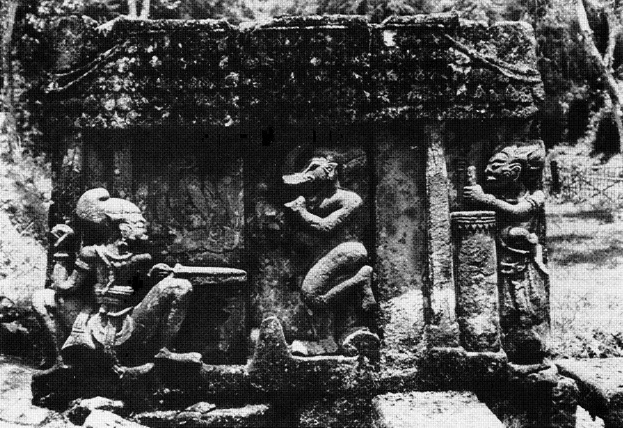
Pl. 1 Relief of smithy at Candi Sukuh, central Java. On the left, a smith forging a weapon. Person on left (Bhima) is surrounded by tools and weapons and is forging a sword.In the center, a dancing elephant-headed figure. Far right, an assistant operating the traditional double-piston bellows of Southeast Asia.
Pl. 2 Detail of Pl. 1 showing smith grasping tang of weapon with bare hand. Note the blade rests on the smith's knee. There is no hammer in the upraised hand.
Pl. 3 The elephant-headed figure, almost crtainly Ganesha, wears a crown and carries a small animal, probably a dog (jackal looking backwards?)
Pl. 4 Detail showing bone rosary or rattle carried by Ganesha.

Pl. 5 Phallus and vulva repreented, on the floor of the monumental gateway at Sukuh. (Portable furnace, bottom register of the standard device hieroglyph on over 1000 inscriptions of Indus script corpora?)
Pl. 6 Linga discovered at Candi Sukuh and now in Museum Pusst, Jakarta (from CJ van der VLie, Report of 1843).Linga is six feet long, five feet in circumference. Old Javanese inscription: 'Consecration of the Holy Gangga sudhi...the sign of masculinity is the essence of the world.' Sword is carved in relief on the shaft of the linga.
Metallurgy and Immortality at Caṇḍi Sukuh, Central Java by Stanley J. O'Connor, Indonesia, Volume 39 (April 1985), 53--70.
 Ganapati, Maha Rakta "After the rise of Tantric Buddhism, Ganesha
Ganapati, Maha Rakta "After the rise of Tantric Buddhism, Ganesha became a Tantric wealth deity and is known as the "Lord of Provisions in Tibetan Tantrism". According to legend, Red Jambhala was in charge of the heavenly treasury that belonged to Lord Mahesvara’s son. Due to his extreme compassion, Red Jambhala had unfailingly answered the prayers of many worshippers. Enraged by Red Jambhala’s indiscriminate charity to both the good and evil, Dharma guardian Mahakala decapitated him. It was only after the wealth deity repents that Mahakala plants an elephant’s head on his neck and receives him as a retainer." http://en.wikipedia.org/wiki/Jambhala

Uchchhishta Ganapati,Nageswaraswamy Temple, Kumbakonam. The deities touch each other's genitalia.

Uchchhishta Ganapati, Nanjangud
"Uchchhishta Ganapati (Sanskrit: उच्छिष्ट-गणपति, Ucchiṣṭa Gaṇapati) is an Tantric aspect of the Hindu god Ganesha (Ganapati). He is the primary deity of the Uchchhishta Ganapatya sect, one of six major schools of the Ganapatyas. He is worshipped primarily by heterodox vamachara rituals. He is depicted with a nude goddess, in an erotic iconography. He is one of the thirty-two forms of Ganesha, frequently mentioned in devotional literature.Herambasuta was one of the exponent of Uchichhishta Ganapati cult." http://en.wikipedia.org/wiki/Uchchhishta_Ganapati
The Kriyakramadyoti mentions that the god carries in his six hands: a lotus (in some descriptions, a blue lotus),a pomegranate, theveena, an akshamala (rosary) and a rice sprig. (Satguru Sivaya Subramuniyaswami. Loving Ganesha. Himalayan Academy Publications. p. 66).
References
Robert Hertz: A contribution to the study of collective representation of death
R. Goris: The position of the blacksmiths, in: Bali: Studies in Life, Thought and Ritual, ed. JC Swellegebel (The Hague: van Hoeve, 1960), pp. 291-97.
ED Baumann, De Mythe van der Manken God, quoted in RJ Forbes, Metallurgy in Antiquity (Leiden: Brill, 1950), p. 89 TheToraja of Sulawesi have a smith god who reforges souls.
Glosses
ulkāˊ f. ʻ meteor, fire falling from heaven ʼ RV., ʻ fire- brand ʼ ŚBr.Pa. ukkā -- f. ʻ torch ʼ, Pk. ukkā -- f ʻ meteor, fire -- ball ʼ; B. ūk, ukā ʻ torch ʼ; Or. uka ʻ torch, flash of fire, meteor ʼ, ukiā ʻ sun's rays ʼ; Mth. ūk ʻ torch ʼ; H. ūk m. ʻ torch, blaze, meteor ʼ.(CDIAL 2362). Rebus: ukku 'steel' (Telugu) Ta. uruku (uruki-) to dissolve (intr.) with heat, melt, liquefy, be fused, become tender, melt (as the heart), be kind, glow with love, be emaciated; urukku (urukki-) to melt (tr.) with heat (as metals or congealed substances), dissolve, liquefy, fuse, soften (as feelings), reduce, emaciate (as the body), destroy; n. steel, anything melted, product of liquefaction; urukkam melting of heart, tenderness, compassion, love (as to a deity, friend, or child); urukkiṉam that which facilitates the fusion of metals (as borax). Ma. urukuka to melt, dissolve, be softened; urukkuka to melt (tr.); urukkam melting, anguish; urukku what is melted, fused metal, steel. Ko. uk steel. Ka.urku, ukku id. Koḍ. ur- (uri-) to melt (intr.); urïk- (urïki-) id. (tr.); ukkï steel. Te. ukku id. Go. (Mu.) urī-, (Ko.) uṛi- to be melted, dissolved; tr. (Mu.) urih-/urh-(Voc. 262). Konḍa (BB) rūg- to melt, dissolve. Kui ūra (ūri-) to be dissolved; pl. action ūrka (ūrki-); rūga (rūgi-) to be dissolved. Kuwi (Ṭ.) rūy- to be dissolved; (S.)rūkhnai to smelt; (Isr.) uku, (S.) ukku steel. (DEDR 661)
mēṇḍhra -- m. ʻ penis ʼ(Samskritam)(CDIAL 9606).Rebus: meḍ 'iron' (Ho.)
ibha m. ʻ elephant ʼ Mn. Pa. ibha-- m., Pk. ibha--, iha--, Si. iba Geiger EGS 22: rather ← Pa.(CDIAL 1587).Rebus: ib 'iron' (Santali)
WPah.kṭg. (kc.) mōr ʻ peacock ʼ.A. mairā ʻ peacock ʼ(CDIAL 9865). Rebus: mará m. ʻ *death ʼ (ʻ world of death ʼ AitUp.), maraka- m. ʻ epidemic ʼ. [√mr̥ ] Pk. mara -- m. ʻ death ʼ, Ash. mə́rə, Wg. mara (as ʻ god of death ʼ(CDIAL 9867).
Pk. kolhuya -- , kulha -- m. ʻ jackal ʼ < *kōḍhu -- ; H. kolhā, °lā m. ʻ jackal ʼ, adj. ʻ crafty ʼ; G. kohlũ, °lũ n. ʻ jackal ʼ, M. kolhā, °lā m.(CDIAL 3615). Rebus: kol 'working in iron' (Tamil) Ta. kol working in iron, blacksmith; kollaṉ blacksmith. Ma. kollan blacksmith, artificer. Ko. kole·l smithy, temple in Kota village. To. kwala·l Kota smithy. Ka.kolime, kolume, kulame, kulime, kulume, kulme fire-pit, furnace; (Bell.; U.P.U.) konimi blacksmith; (Gowda) kolla id. Koḍ. kollë blacksmith. Te. kolimi furnace.Go. (SR.) kollusānā to mend implements; (Ph.) kolstānā, kulsānā to forge; (Tr.) kōlstānā to repair (of ploughshares); (SR.) kolmi smithy (Voc. 948). Kuwi (F.) kolhalito forge. (DEDR 2133)
K. khāra -- basta f. ʻ blacksmith's skin bellows ʼ; -- S. bathī f. ʻ quiver ʼ (< *bhathī); A. Or. bhāti ʻ bellows ʼ, Bi. bhāthī, (S of Ganges) bhã̄thī; OAw. bhāthā̆ ʻ quiver ʼ; H. bhāthā m. ʻ quiver ʼ, bhāthī f. ʻ bellows ʼ; G. bhāthɔ, bhātɔ, bhāthṛɔ m. ʻ quiver ʼ (whence bhāthī m. ʻ warrior ʼ); M. bhātā m. ʻ leathern bag, bellows, quiver ʼ, bhātaḍ n. ʻ bellows, quiver ʼ; <-> (Xbhráṣṭra -- ?) N. bhã̄ṭi ʻ bellows ʼ, H. bhāṭhī f. OA. bhāthi ʻ bellows ʼ (CDIAL 9424). Rebus: Pk. bhayaga -- m. ʻ servant ʼ, bhaḍa -- m. ʻ soldier ʼ, bhaḍaa -- m. ʻ member of a non -- Aryan tribe ʼ; Paš. buṛīˊ ʻ servant maid ʼ IIFL iii 3, 38; S.bhaṛu ʻ clever, proficient ʼ, m. ʻ an adept ʼ; Ku. bhaṛ m. ʻ hero, brave man ʼ, gng. adj. ʻ mighty ʼ; B. bhaṛ ʻ soldier, servant, nom. prop. ʼ,.kcch. bhaṛ ʻ brave ʼ; Garh. (Śrīnagrī dial.) bhɔṛ, (Salānī dial.) bhe ṛ ʻ warrior ʼ.G. bhaṛ m. ʻ warrior, hero, opulent person ʼ, adj. ʻ strong, opulent ʼ (CDIAL 9588).
http://www.academicroom.com/article/tantri-reliefs-javanese-candi
See: http://archive.org/stream/parwwa-tantri-kamandaka/parwwa-tantri-kamandaka-250ppi#page/n5/mode/1up Parwwa Tantri Kamandaka, Pusat Dokumentasi, Dinas Kebudayaan Provinsi Bali
See: http://www.museumneka.com/keris.asp
Majapahit era in Indonesia has books such as Candidate Charcoal, Korawasrama, Babhulisah, Tantri Kamandaka, Pancatantra and temples such as Temple Brahu, Temple Gentong, Blitar, Tegalwangi Mice.
Magic of Metal. Physical and spiritual powers of keris. Watch out, deadly curves!
![]() Surya Majapahit[i] of Majapahit Empire from 1293 to around 1500 in Java, Indonesia.
Surya Majapahit[i] of Majapahit Empire from 1293 to around 1500 in Java, Indonesia.![]()
![]() The graceful Bidadari Majapahit, golden celestialapsara in Majapahit style perfectly describes Majapahit as "the golden age" of the archipelago.
The graceful Bidadari Majapahit, golden celestialapsara in Majapahit style perfectly describes Majapahit as "the golden age" of the archipelago.![]()
![]() The statue of Harihara, the god combination of Shiva andVishnu. It was the mortuary deified portrayal ofKertarajasa. Originally located at Candi Simping, Blitar and the statue is now preserved at the National Museum of Indonesia.
The statue of Harihara, the god combination of Shiva andVishnu. It was the mortuary deified portrayal ofKertarajasa. Originally located at Candi Simping, Blitar and the statue is now preserved at the National Museum of Indonesia.
Family tree and demographics: Ethnologue index of AA languages. Maps: Typology and Drift: Bibliography: Journals: Lexicography: Etymology: Scanned images:
Last edited 11/27/2005. Corrections to David Stampe and Patricia Donegan, University of Hawai`i Dept. of Linguistics, Honolulu, Hawai`i 96825 USA. http://www.ling.hawaii.edu/austroasiatic/
![Agastya: This statue of Agastya, who is credited with propagating Hinduism in Java, originated from Nagasari Temple from the Prambanan complex in Yogyakarta.]() Agastya: This statue of Agastya, who is credited with propagating Hinduism in Java, originated from Nagasari Temple from the Prambanan complex in Yogyakarta. - See more at: http://www.thejakartapost.com/news/2013/11/15/javanese-antiquities-paris.html#sthash.pf1sXQyl.dpuf
Agastya: This statue of Agastya, who is credited with propagating Hinduism in Java, originated from Nagasari Temple from the Prambanan complex in Yogyakarta. - See more at: http://www.thejakartapost.com/news/2013/11/15/javanese-antiquities-paris.html#sthash.pf1sXQyl.dpuf
See https://books.google.co.in/books?id=oF-Hqih3pBAC&pg See: Brown, Robert L., 1991, Ganesh: Studies of an Asian God, SUNY Press, Book News, Inc., Portland, OR. Essentially a collection of full plot summaries organized under country of origin and preceeded by brief historical introduction. Covers Britain, France, US, Austria-Germany-Hungary, and Spain. Indexed by author/composer/lyricist, and by song title. Includes a discography. Ganesk, the Indian, elephant-headed god worshipped by some Hindus as the principle god, and by many as a subsidiary god, gets a full measure of devotion from western scholars in 11 essays concerned primarily with his origins, rise to divinity, and spreading popularity. The topics include his protohistory, myth, metaphor; his wives; and his place in Sanscrit literature, Jainism, southeast Asia, Tibet, China, and Japan. Annotation copyrighted by Book News, Inc., Portland, OR
References
Robert Hertz: A contribution to the study of collective representation of death
R. Goris: The position of the blacksmiths, in: Bali: Studies in Life, Thought and Ritual, ed. JC Swellegebel (The Hague: van Hoeve, 1960), pp. 291-97.
ED Baumann, De Mythe van der Manken God, quoted in RJ Forbes, Metallurgy in Antiquity (Leiden: Brill, 1950), p. 89 TheToraja of Sulawesi have a smith god who reforges souls.
Glosses
ulkāˊ f. ʻ meteor, fire falling from heaven ʼ RV., ʻ fire- brand ʼ ŚBr.Pa. ukkā -- f. ʻ torch ʼ, Pk. ukkā -- f ʻ meteor, fire -- ball ʼ; B. ūk, ukā ʻ torch ʼ; Or. uka ʻ torch, flash of fire, meteor ʼ, ukiā ʻ sun's rays ʼ; Mth. ūk ʻ torch ʼ; H. ūk m. ʻ torch, blaze, meteor ʼ.(CDIAL 2362). Rebus: ukku 'steel' (Telugu) Ta. uruku (uruki-) to dissolve (intr.) with heat, melt, liquefy, be fused, become tender, melt (as the heart), be kind, glow with love, be emaciated; urukku (urukki-) to melt (tr.) with heat (as metals or congealed substances), dissolve, liquefy, fuse, soften (as feelings), reduce, emaciate (as the body), destroy; n. steel, anything melted, product of liquefaction; urukkam melting of heart, tenderness, compassion, love (as to a deity, friend, or child); urukkiṉam that which facilitates the fusion of metals (as borax). Ma. urukuka to melt, dissolve, be softened; urukkuka to melt (tr.); urukkam melting, anguish; urukku what is melted, fused metal, steel. Ko. uk steel. Ka.urku, ukku id. Koḍ. ur- (uri-) to melt (intr.); urïk- (urïki-) id. (tr.); ukkï steel. Te. ukku id. Go. (Mu.) urī-, (Ko.) uṛi- to be melted, dissolved; tr. (Mu.) urih-/urh-(Voc. 262). Konḍa (BB) rūg- to melt, dissolve. Kui ūra (ūri-) to be dissolved; pl. action ūrka (ūrki-); rūga (rūgi-) to be dissolved. Kuwi (Ṭ.) rūy- to be dissolved; (S.)rūkhnai to smelt; (Isr.) uku, (S.) ukku steel. (DEDR 661)
mēṇḍhra -- m. ʻ penis ʼ(Samskritam)(CDIAL 9606).Rebus: meḍ 'iron' (Ho.)
ibha m. ʻ elephant ʼ Mn. Pa. ibha-- m., Pk. ibha--, iha--, Si. iba Geiger EGS 22: rather ← Pa.(CDIAL 1587).Rebus: ib 'iron' (Santali)
WPah.kṭg. (kc.) mōr ʻ peacock ʼ.A. mairā ʻ peacock ʼ(CDIAL 9865). Rebus: mará m. ʻ *death ʼ (ʻ world of death ʼ AitUp.), maraka- m. ʻ epidemic ʼ. [√
Pk. kolhuya -- , kulha -- m. ʻ jackal ʼ < *kōḍhu -- ; H. kolhā, °lā m. ʻ jackal ʼ, adj. ʻ crafty ʼ; G. kohlũ, °lũ n. ʻ jackal ʼ, M. kolhā, °lā m.(CDIAL 3615). Rebus: kol 'working in iron' (Tamil) Ta. kol working in iron, blacksmith; kollaṉ blacksmith. Ma. kollan blacksmith, artificer. Ko. kole·l smithy, temple in Kota village. To. kwala·l Kota smithy. Ka.kolime, kolume, kulame, kulime, kulume, kulme fire-pit, furnace; (Bell.; U.P.U.) konimi blacksmith; (Gowda) kolla id. Koḍ. kollë blacksmith. Te. kolimi furnace.Go. (SR.) kollusānā to mend implements; (Ph.) kolstānā, kulsānā to forge; (Tr.) kōlstānā to repair (of ploughshares); (SR.) kolmi smithy (Voc. 948). Kuwi (F.) kolhalito forge. (DEDR 2133)
K. khāra -- basta f. ʻ blacksmith's skin bellows ʼ; -- S. bathī f. ʻ quiver ʼ (< *bhathī); A. Or. bhāti ʻ bellows ʼ, Bi. bhāthī, (S of Ganges) bhã̄thī; OAw. bhāthā̆ ʻ quiver ʼ; H. bhāthā m. ʻ quiver ʼ, bhāthī f. ʻ bellows ʼ; G. bhāthɔ, bhātɔ, bhāthṛɔ m. ʻ quiver ʼ (whence bhāthī m. ʻ warrior ʼ); M. bhātā m. ʻ leathern bag, bellows, quiver ʼ, bhātaḍ n. ʻ bellows, quiver ʼ; <-> (X
Tantri Reliefs on Javanese Candi by Robert L. Brown Journal of the American Oriental Society, Vol. 118, Issue 1, 1998
http://www.academicroom.com/article/tantri-reliefs-javanese-candi
See: http://archive.org/stream/parwwa-tantri-kamandaka/parwwa-tantri-kamandaka-250ppi#page/n5/mode/1up Parwwa Tantri Kamandaka, Pusat Dokumentasi, Dinas Kebudayaan Provinsi Bali
See: http://www.museumneka.com/keris.asp
Majapahit era in Indonesia has books such as Candidate Charcoal, Korawasrama, Babhulisah, Tantri Kamandaka, Pancatantra and temples such as Temple Brahu, Temple Gentong, Blitar, Tegalwangi Mice.
Magic of Metal. Physical and spiritual powers of keris. Watch out, deadly curves!
"No, this is not a traffic sign warning drivers of a dangerous winding road, but a rather inadequate description of keris, the traditional Indonesian dagger. Whether created by human hands or of supernatural origin, keris are believed to be physical manifestations of invisible forces. Forged in fire but symbolic of water, a keris represents a powerful union of cosmic complementary forces.
A distinctive feature of many keris is their odd-numbers of curves, but they also have straight blades. Keris are like naga, which are associated with irrigation canals, rivers, springs, wells, spouts, waterfalls and rainbows. Some keris have a naga or serpent head carved near its base with the body and tail following the curves of the blade to the tip. A wavy keris is a naga in motion, aggressive and alive; a straight blade is one at rest, its power dormant but ready to come into action.
Different types of whetstones, acidic juice of citrus fruits and poisonous arsenic bring out the contrast between the dark black iron and the light colored silvery nickel layers which together form pamor, damascene patterns on the blade. These motifs have specific names which indicate their special powers: udan mas (golden rain) is good for prosperity, wos wetah (unbroken rice grains) brings well-being.
Three fingers remaining helps in making decisions; two fingers left are good for spiritual purposes. One and a half fingers left repel disaster and black magic; one finger remaining is suitable for agricultural prosperity. Half a finger left is useful for thieves; no finger remaining is good for making proposals. What’s going on here? Cutting off fingers for punishment? No, by measuring a keris from base to tip with four fingers of each hand alternating, the remaining length indicates how the keris is beneficial.
The keris is an important family possession and considered to be an ancestral deity, as weapons often play critical roles in the rise and fall of families and fortunes in history. Heirloom keris have proper names which describe their power: Ki Sudamala is Venerable Exorcist and repels negative forces, Ki Baju Rante is Venerable Coat of Armor and spiritually protects one wearing it.
In Bali, an heirloom keris and other such metal objects are presented offerings every 210 days on the day called Tumpek Landep, which means ‘sharp’. They are cleaned, displayed in temple shrines, and presented with incense, holy water, and red-colored food and flowers to honor Hindu god of fire Brahma. This is followed by prayers for a sharp mind to Sanghyang Pasupati, the deity who empowers sacred objects and defeats ignorance..."
 Suteja Neka ritually hammers a newkeris being made for the Pura Pandeblacksmith clan temple in Peliatan in June 2006 Suteja Neka ritually hammers a newkeris being made for the Pura Pandeblacksmith clan temple in Peliatan in June 2006 Antique royal Balinese keris from Bangliwith 17 curves, demon-shaped handle inlaid with gold and encrusted with semi-precious stones  Antique Balinese keris with chiseled figures of lion king Candapinggala fighting bull Nandaka from the TantriKamandaka fables  Antique Balinese keris with 13 curves, new gold inlay of naga(water-serpent), demon-shaped gold handle encrusted with semi-precious stones |
"There are also 14 stories from the Tantri Kamandaka, these are Java animal fables used to represent characters that teach life lessons in wisdom & statecraft, the art of running a kingdom. The Tantri Kamandaka is interesting as it is very similar to the Arabian ‘A Thousand & One Nights’ story. It starts off with a king who orders his minister to find him a bride each night so his subjects can get drunk & have a wedding feast every day. On the last day the kingdom runs out of girls & so the minister’s own daughter, a girl named Tantri gives herself up. On their wedding night in order to avoid drunken horizontal-mumble, she tries to distract the king with these tales which later has a profound effect on the king who vows to change his ways, the moral here… if you have sex with a different woman every night you will probably get AIDS & die."
Javanese Tantri Kamandaka (known also as Tantricarita, Tantravakya and Candapingala) is based on Pancatantra. Prof. C. Hooykaas brought out a Tantri edition in 1931. He opines that this book was written at about the same time as Durgasimha's Kannada version of the Pancatantra, that is, in the first half of the eleventh century CE.
English translation:
'"This work will, in all likelihood, be of interest to rulers; for the course of (princely) policy is made plain by stories of animals."
 Surya Majapahit[i] of Majapahit Empire from 1293 to around 1500 in Java, Indonesia.
Surya Majapahit[i] of Majapahit Empire from 1293 to around 1500 in Java, Indonesia.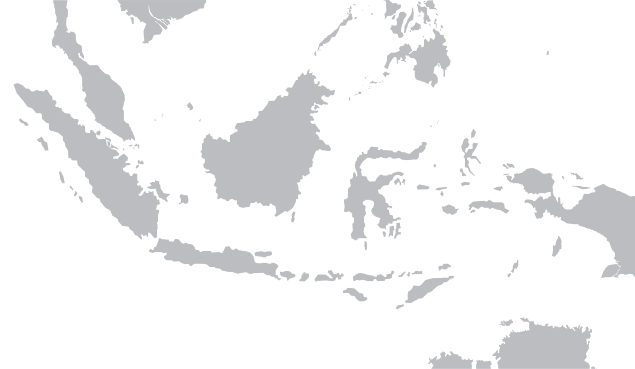
Expansion and decline of Majapahit Empire, started in Trowulan Majapahit in 13th century, expanded to much of Indonesian archipelago, until receded and fell in early 16th century.
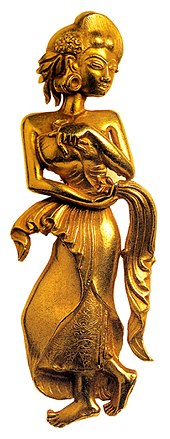 The graceful Bidadari Majapahit, golden celestialapsara in Majapahit style perfectly describes Majapahit as "the golden age" of the archipelago.
The graceful Bidadari Majapahit, golden celestialapsara in Majapahit style perfectly describes Majapahit as "the golden age" of the archipelago.
Bas relief from Candi Penatarandescribes the Javanese-style pendopopavilion, commonly found across Java and Bali.
Majapahit recognize the hierarchy classifications of lands within its realm:
- Bhumi: the kingdom, ruled by the king
- Nagara: the province, ruled by the rajya (governor), or natha (lord), or bhre (prince or duke)
- Watek: the regency, administered by wiyasa,
- Kuwu: the district, administered by lurah,
- Wanua: the village, administered by thani,
- Kabuyutan: the hamlet or sanctuary place.
The officials in Majapahit courts are:
- Rakryan Mahamantri Katrini, usually reserved for the king's heir
- Rakryan Mantri ri Pakira-kiran, the board of ministers that conduct the daily administration
- Dharmmadhyaksa, the officials of laws, state laws as well as religious laws
- Dharmma-upapatti, the officials concerning religious affairs
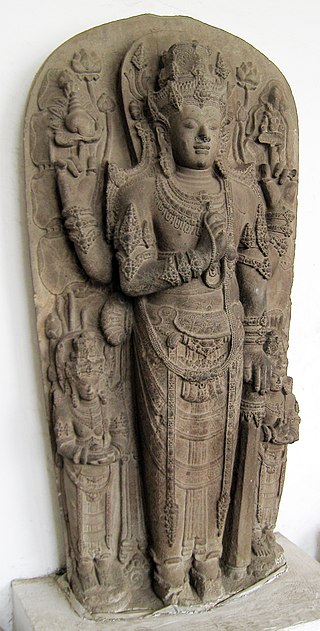 The statue of Harihara, the god combination of Shiva andVishnu. It was the mortuary deified portrayal ofKertarajasa. Originally located at Candi Simping, Blitar and the statue is now preserved at the National Museum of Indonesia.
The statue of Harihara, the god combination of Shiva andVishnu. It was the mortuary deified portrayal ofKertarajasa. Originally located at Candi Simping, Blitar and the statue is now preserved at the National Museum of Indonesia.  | Austroasiatic Languages: Munda (Eastern India) and Mon-Khmer (NE India, mainland SE Asia, Malaysia, Nicobars) |
- Austroasiatic languages map (in German) from H.-J. Pinnow's Versuch einer historischen Lautlehre der Kharia-Sprache, 1958: map (jpg-file); legend (jpg-file). Vietnamese is omitted.
- Mainland SE Asian language maps compiled by David Bradley (part of Wurm & Hattori's Language Atlas of the Pacific Area (1981, 1983):
- Patricia J. Donegan & David Stampe, Rhythm and the holistic organization of language structure (.pdf file), a corrected version of a paper originally published in Papers from the Parasession on the Interplay of Phonology, Morphology, and Syntax, ed. John F. Richardson, Mitchell Marks, and Amy Chukerman (Chicago: Chicago Linguistic Society, 1983), pp. 337-353.
- Patricia J. Donegan, Rhythm and vocalic drift in Munda and Mon-Khmer (.pdf file), in Linguistics of the Tibeto-Burman Area 16.1.1-43 (1996).
- Patricia J. Donegan & David Stampe, South-East Asian features in the Munda languages: Evidence for the analytic-to-synthetic drift of Munda (.pdf file), in Proceedings of the 28th Annual Meeting of the Berkeley Linguistics Society, Special Session on Tibeto-Burman and Southeast Asian Linguistics, in honor of Prof. James A. Matisoff, ed. Patrick Chew (Berkeley: Berkeley Linguistics Society, 2002), pp. 111-129.
- Patricia J. Donegan & David Stampe, Rhythm and the synthetic drift of Munda (.pdf file), in Rajendra Singh (ed.), The Yearbook of South Asian Languages and Linguistics 2004, pp. 3-36.
- Austroasiatic bibliography of John Peterson.
- Munda Bibliography to 1983 by David Stampe.
- Bibliography and Index of Mainland SE Asian Languages and Linguistics (New Haven: Yale University Press, 1986), by Franklin Huffman, including Munda and the Indian language isolate Nihali -- input by David Stampe et al. (through L, with some addenda and library locations).
- Doug Cooper's SEA Linguistics Bibliography site includes his Thai and computational linguistics bibliography, as well as the two bibliographies by Stampe and Huffman, above, as targets of Doug's versatile search and reformatting engine. NO LONGER ONLINE
- Munda Lexical Archive, an ongoing copylefted archive of most of the lexical materials available from the non-Kherwarian Munda languages, assembled, analyzed, and arranged by Patricia J. Donegan & David Stampe. A detailed description with credits is forthcoming. For now see 00README. (A current snapshot of the whole is available for download as a zip archive: munda-archive.zip)
- Sora (Saora, Savara), data of G. V. Ramamurti, Verrier Elwin, H. S. Biligiri, David Stampe, Stanley Starosta, Bijoy P. Mahapatra, Ranganayaki Mahapatra, Arlene R. K. Zide, Khageswar Mahapatra, Piers Vitebsky, Patricia J. Donegan, et al.
- Gorum (Parengi), data of Arlene R. K. Zide et al.
- Gutob (Gadaba), data of Norman H. Zide, Bimal Prasad Das, Patricia J. Donegan, et al.
- Remo (Bonda), data of Verrier Elwin, Frank Fernandez, S. Bhattacharya, Patricia J. Donegan, et al.
- Gta' (Didayi), data of Suhas Chatterji, P. N. Chakravarti, Norman H. Zide, Khageswar Mahapatra, Patricia J. Donegan, et al.
- Kharia, data of H. Floor, H. Geysens, H. S. Biligiri, Heinz-Jürgen Pinnow, et al.
- Juang, data of Verrier Elwin, Dan M. Matson, Bijoy P. Mahapatra, Heinz-Jürgen Pinnow, et al.
- Korku, data of Norman H. Zide, Beryl A. Girard, Patricia J. Donegan, et al.
- Santali, a growing selection of Paul Otto Bodding's 5-volume A Santal Dictionary (Oslo, Norske Videnskaps-Akademi, 1929-1936), input by Makoto Minegishi and associates, ILCAA, Tokyo, but so far of limited value since it is accessible only by searching for an exactly spelled Santali headword! .
- Munda:
- Comparative Munda (mostly North), rough draft ed. Stampe, based on Heinz-Jürgen Pinnow's Versuch einer historischen Lautlehre der Kharia-Sprache (Wiesbaden: Harrassowitz, 1959) and Ram Dayal Munda's Proto-Kherwarian Phonology, unpublished MA thesis, University of Chicago, 1968.
- Working files of South Munda lexical data by gloss assembled from collections of David Stampe, Patricia Donegan, H.-J. Pinnow, Sudhibhushan Bhattacharya, and Norman and Arlene Zide for a seminar by Stampe on Austroasiatic languages.
- Indian Substratum: South Asia Residual Vocabulary Assemblage (SARVA), a compilation of ancient Indian words lacking apparent Indo-Aryan, Dravidian, or Austroasiatic origins, in progress by Franklin Southworth and Michael Witzel, with David Stampe.
- Dravidian: Thomas Burrow and Murray B. Emeneau's A Dravidian Etymological Dictionary, Oxford and New York: Oxford University Press, 2nd ed. 1984. Accessible by search on headwords or strings, through the Digital Dictionaries of South Asia project, U. Chicago.
- Indo-Aryan: Sir Ralph Turner's A Comparative Dictionary of Indo-Aryan Languages, London: Oxford University Press, 1962-66, with 3 supplements 1969-85. Accessible by search on headwords or strings, through the Digital Dictionaries of South Asia project, U. Chicago.
- Sino-Tibetan: James A. Matisoff's STEDT (Sino-Tibetan Etymological Dictionary and Thesaurus) Project, at Berkeley. The first fruit of the project, Matisoff's Handbook of Proto-Tibeto-Burman: System and Philosophy of Sino-Tibetan Reconstruction (University of California Publications in Linguistics 135), 2003, can be downloaded from California's eScholarship Repository as a searchable pdf file. On the STEDT site is an index of reconstructions and a first set of addenda and corrigenda for HPTB. Electronic publication of STEDT is planned in 8 semantically arranged fascicles.
- Munda: Sir George Grierson, Linguistic Survey of India, Calcutta, 1904-1928, 7 vols, part of GICAS project at TUFS, Tokyo, pdf scanned images accessible by text search.
- Sora: Anonymous, Language Hand-book Savara, Calcutta, Tea Districts Labour Association, 1927, iv, 137 pp.: pdf-file (4.9mB !).
- Sora: G. V. Ramamurti, Sora-English Dictionary, Madras, 1938, xxxvi, 318 pp. (repr. Delhi, Mittal, 1983): pdf-file (21.9mB !).
- Sora: Tabme Anosaijan (The New Testament in Sora), Bangalore: The Bible Society of India and Ceylon, 1965: pdf-file (36.8mB !).
Last edited 11/27/2005. Corrections to David Stampe and Patricia Donegan, University of Hawai`i Dept. of Linguistics, Honolulu, Hawai`i 96825 USA.
The eighteenth annual meeting of the Southeast Asian Linguistics Society (Kuala Lumpur
Paul Sidwell
Centre for Research in Computational Linguistics
<paulsidwell@yahoo.com>
Abstract
Is Mon-Khmer dead? Long live Austroasiatic!
In reviewing the classification of Austroasiatic languages in the twentieth century, it is evident that cleanly identifying the constituency of a “Mon-Khmer” family within the phylum has never been satisfactorily resolved. Initially narrowly defined, the putative membership of Mon-Khmer steadily expanded over time; perhaps the only consistent characteristic of alternative formulations was the lack of any claim to the Munda languages of India
Looking back, it is apparent that this view emerged absent a comprehensive Austroasiatic reconstruction, by researchers who relied on typological, lexical, and lexicostatistical considerations in making their classifications. But this methodology, however reasonable, has created divisions that go far beyond simple language classification. Over the last half century there has been an ongoing social separation between Mon-Khmer and Munda (mostly India-based) scholars; unfortunate if the existing classification paradigm is correct, but needless and harmful if it turns out that our attitudes and work practices have been framed around a model that is ultimately disproved.
While the Austroasiatic conferences held in India in 1977 and 2007 provided excellent opportunities for bridge-building, the three-decades gap between meetings is itself evidence of the conceptual fragmentation that has paralleled the geographic – as opposed to linguistic – distance between Munda and Mon-Khmer. In fact, from the comparative-historical viewpoint there are no data that decisively indicate that all of the Mon-Khmer languages are closer to each other than any are to Munda. Indeed, new and conflicting classification models have been advanced (e.g. Peiros 2004, Diffloth 2005), and it has been argued that the Munda languages are structurally innovative rather than archaic (e.g. Donegan & Stampe 2004). It may well be that Munda is best viewed as a typologically variant Northern Mon-Khmer branch (for want of a better term).
These considerations highlight just how precarious are our traditions of treating Munda as a distant cousin, while taking for granted the pairing of Mon and Khmer in a single sub-branch. On the contrary, we should recognize Munda’s integral role in the comparative study of the Austroasiatic languages of Southeast Asia , and go on to ask if there is any true cladistic motivation that requires the term “Mon-Khmer” at all. More importantly, even as we use modern resources and improved methods to help resolve technical issues of clades and branchings, it is equally imperative that we work to bring South Asian and Southeast Asian linguists together in an inclusive research community of Austroasiatic scholars.
References
Diffloth, Gérard. 2005. The contribution of linguistic palaeontology to the homeland of Austro-asiatic. In: Sagart, Laurent , Roger Blench and Alicia Sanchez-Mazas (eds.). The Peopling of East Asia : Putting Together Archaeology, Linguistics and Genetics. Routledge/Curzon. pp79-82.
Peiros, Iľja J. 2004. Genetičeskaja klassifikacija avstroaziatskix jazykov. Moskva: Rossijskij gosudarstvennyj gumanitarnyj universitet (doctoral dissertation).
Donegan, Patricia and David Stampe. 2004. Rhythm and the Synthetic Drift of Munda, The Yearbook of South Asian Languages and Linguistics. Berlin and New York
 Agastya: This statue of Agastya, who is credited with propagating Hinduism in Java, originated from Nagasari Temple from the Prambanan complex in Yogyakarta. - See more at: http://www.thejakartapost.com/news/2013/11/15/javanese-antiquities-paris.html#sthash.pf1sXQyl.dpuf
Agastya: This statue of Agastya, who is credited with propagating Hinduism in Java, originated from Nagasari Temple from the Prambanan complex in Yogyakarta. - See more at: http://www.thejakartapost.com/news/2013/11/15/javanese-antiquities-paris.html#sthash.pf1sXQyl.dpuf See https://books.google.co.in/books?id=oF-Hqih3pBAC&pg See: Brown, Robert L., 1991, Ganesh: Studies of an Asian God, SUNY Press, Book News, Inc., Portland, OR. Essentially a collection of full plot summaries organized under country of origin and preceeded by brief historical introduction. Covers Britain, France, US, Austria-Germany-Hungary, and Spain. Indexed by author/composer/lyricist, and by song title. Includes a discography. Ganesk, the Indian, elephant-headed god worshipped by some Hindus as the principle god, and by many as a subsidiary god, gets a full measure of devotion from western scholars in 11 essays concerned primarily with his origins, rise to divinity, and spreading popularity. The topics include his protohistory, myth, metaphor; his wives; and his place in Sanscrit literature, Jainism, southeast Asia, Tibet, China, and Japan. Annotation copyrighted by Book News, Inc., Portland, OR
